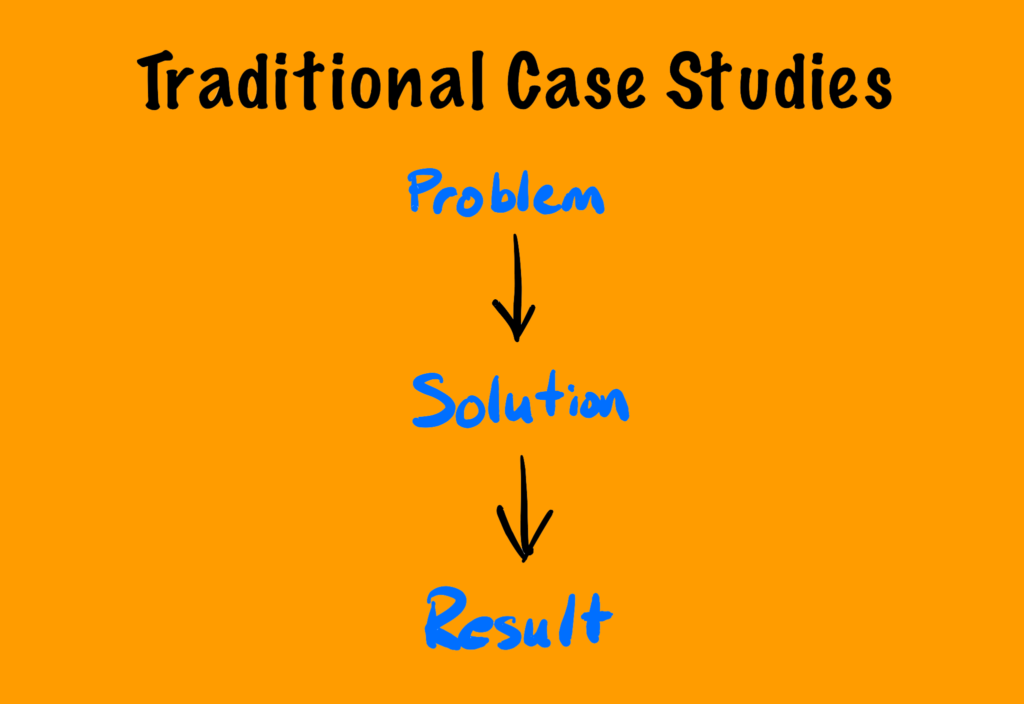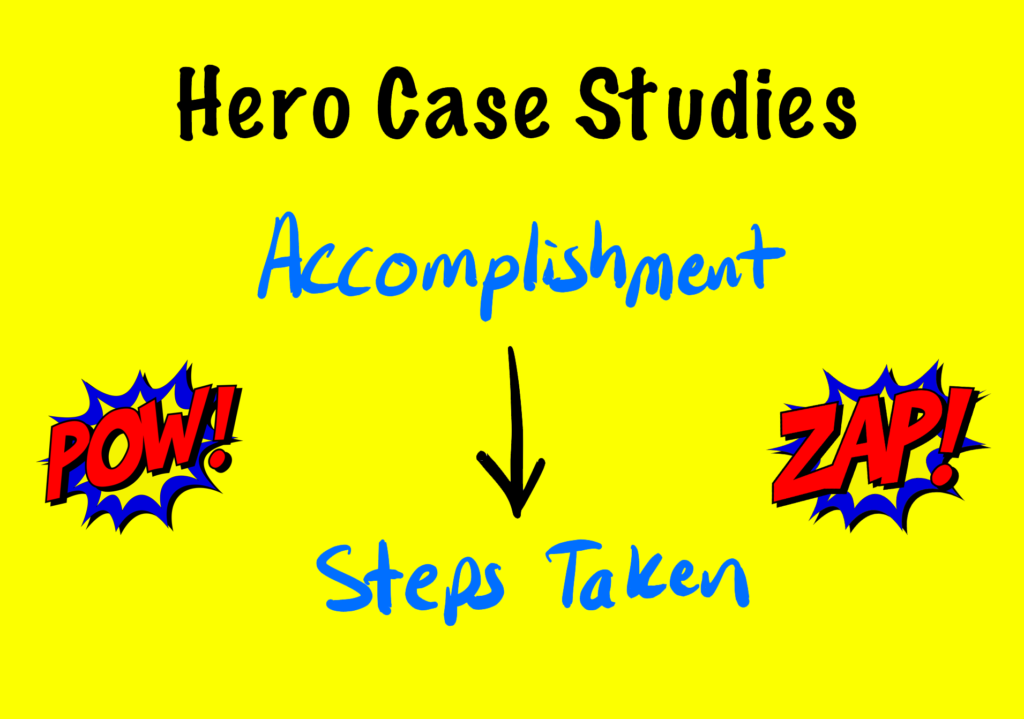This article will help you solve an annoying problem I know many of you face: getting more customers to agree to case studies.
For this method to work, you’ll have to adjust how you write case studies.
The method isn’t difficult. I’ll show you exactly how I do them below (examples included).
The short version of this article is this:
- Stop asking: “Could we write a case study about you?”
- Start asking: “Could we feature you in an article on our blog?” (or on our podcast, YouTube, etc.)
People say “yes” to that second request far more often than they do to the first.
I’ve done this successfully with dozens of companies, and it works exceptionally well.
Here’s:
- Why it works
- How to do it well
- Examples of this style of case study (which is different than a traditional case study)
- Why this “hero case studies” approach often creates far better material than asking for a traditional case study.
Note: Love the “hero case study” approach described in this article? Want me to run the process on your behalf? Get in touch and let’s see if we’re a good fit.
Why Customers Say ‘No’ to Case Study Requests
I’ve been in content marketing since 2008 and was a journalist before that.
Early in my marketing career, I worked for a company that was trying to get more case studies.
We made a lot of asks. Like a lot of asks.
And we heard a lot of this:
- “We’re not interested”
- “We just installed it”
- “We’re not sure we’re ready to be a testimonial.”
Over 90% of the customers we reached out to either said “no” or put us off with a “maybe later” or something similar.

I’m sure some of you can relate.
Getting rejected that often? That’s no fun for anyone.
If you step back from your own needs for a moment, you can start to understand why customers give these kinds of responses.
A traditional case study follows a tried-and-true format:
- Company has a problem
- Company finds a solution (your product)
- The results are awesome.

In the traditional format, the hero of the story is your product or service.
So ask yourself: If you’re going to make your product the hero of the story, what’s in it for the customer?
What incentive do they have to say “yes” to your case study request?
The answer is: not much.
Some people will agree just because they’re polite and don’t like to say “no.”
But that’s about all you have going for you in this situation.
It’s why companies revert to discounts and incentives in exchange for on-the-record case studies — bribing customers to get case studies.
And look, I’m not against an elegant negotiable written into a contract.
But what if you don’t have a discount to offer? What if you’re in marketing and you’ve been tasked to “go get ten new case studies by the end of the quarter!”?
The solution below is the one I finally stumbled into after getting rejected so, so many times all those years ago when asking for traditional case studies.
What if, instead of dreading being asked for a case study, your customers were eager to participate?
As you’ll see below, it’s all in how you ask. 🙂
When I Was a Journalist, No One Ever Turned Me Down for a Feature
I’m a former journalist.
I spent two years working at a community newspaper, where I wrote a lot of feature articles.

Here’s a fact:
People loved being profiled in the newspaper.
No one ever said no when I asked to feature them in a story. Ever.
They adored being asked about their life and their stories. I couldn’t get many of them to stop talking once we got into the interview.
Note: Want customers to say “yes” to your case study requests? I can run the entire process described in this article on your behalf, from initial outreach and interviews all the way to final approval and publication. Contact me here if you’d like to get more case studies from your customers.
The Difference Between a Newspaper Feature and a Case Study?
Why is this?
Why are people so excited to be featured in a newspaper article? But so not excited to be featured in your case studies?
Answer: In my newspaper articles, the person I interviewed was the hero of the story.
Getting featured made them feel great. They were proud of their story, and they looked great in front of friends and family.
Prestige. Pride. Respect. Feelings of accomplishment.
These emotions are powerful motivators.
I had multiple times where someone I featured came to the newspaper office the next day and bought multiple copies to send to friends and family who lived out of town.
Wouldn’t you feel special if a newspaper or magazine asked to do a story about you?
Of course you would!
People Will Love Being Featured on Your Blog (or Podcast, etc.)
Forget asking for “case studies.” In fact, don’t mention the words “case study” at all.
Treat your ask like you’re a newspaper writer asking someone with an amazing story if they want to be featured.
It sounds like this:
- “Could we feature you in an article on our blog?”
If you have a podcast or a YouTube series or something like that, it could be:
- Could we feature you on the podcast?
- I’d love to feature you in our newsletter. Would you be open to that?
It’s that simple.
When I made this change, I immediately saw a huge increase in the number of people who said “yes” to my requests.
In fact, they started reacting the same way people used to react when I was a reporter.
They feel like the hero of their story (as we all do!), and they were delighted, flattered, and excited to share their experiences.
I admit that not everyone says yes. So it’s not quite like it was when I worked at the newspaper. They still know I’m working with a marketing department. They know I have an agenda.
Even so, way more people say “yes” today compared to the requests I made a few years ago.
Even now, a decade after I first started using this process, my success rate is close to 50% “yes” when I ask if I can feature someone in a content piece.
Remember this: People love being profiled in articles where they are the hero of the story.
Now, before you get too excited, changing your ask will get you more “yes” responses.
But it also means you’ll have to change how you go about writing your case study.
I still include the product of course. But it’s part of the person’s story. A powerful tool they used to slay a dragon.
Instead of doing a traditional case study, my process takes the person being interviewed and makes them the hero of the story.
Which is why I started calling them “hero case studies.”
How to Write Hero Case Studies
Forget: Problem → Solution → Result.
Instead, the format is this:
- Accomplishment → Steps taken

Writing a hero case study requires you to think like a journalist instead of a brand manager.
In fact, if you can, try not to let your brand manager do the interview for these kinds of articles.
Brand managers are just too into the product. Which is not a bad thing — brand managers should be obsessed with the way customers use your product.
But to do hero case studies well, you must have someone who can be objective, someone who acts like a journalist: focusing on the customer’s story first, not your product or service.
Your product or service becomes a natural part of the story, which (believe it or not) gives your product more credibility than it would in a traditional case study.
Remember this: Hero case studies require journalism skills to do well.
Note: Need a trained journalist to find the story that makes your product or service shine? Contact me here.
Hero Case Studies Work Amazingly Well Across the Sales Funnel
One more thing about hero case studies vs. traditional case studies…
Traditional case studies work great for later-stage sales conversations. They’re perfect for that point where a prospect starts asking for proof of your claims.
But traditional case studies don’t work nearly as well at the top of the funnel. They don’t go viral or get shared around offices. They’re too self-promotional.
Hero case studies, by contrast, are great at the top of the funnel and the bottom of the funnel.
Think about magazines like Entrepreneur or FastCompany — those are full of articles that look just like the ones we’re talking about.
In fact, if you have a good PR strategy, it’s entirely possible to place hero case studies in trade publications or as guest posts for blogs and online magazines.
Try doing that with a traditional case study and see how far you get.
Hero case studies also work at the bottom of the funnel — because they still illustrate a specific use case from a customer.

Remember this: When done right, hero case studies can start sales conversations — and close them.
Examples of Hero Case Studies
Here are a few examples of hero case studies so you know the kind of story I’m talking about.
- Customer Experience Strategy: How This Startup Used Customer Reviews to Gain Traction
- How ‘The Great War’ Co-creates Its Hit YouTube Show with the Help of a 700,000+ Member Audience
- 5 UX Research Lessons from HoneyBook’s Senior UX Researcher
- A Customer Centric Approach: 5 Ways Steve & Kate’s Camps Earns ‘Customers for Life’
See how each one makes the person being profiled the hero of the story?
One More Thing… You Can Use This Approach to Get Traditional Case Studies Too
So far, we’ve just talked about shifting your ask from a traditional case study to a feature story on the blog.
But…
You don’t have to throw out traditional case studies—far from it.
Instead, lead with a feature article request: “Could we feature you in a story on our blog?”
Then, when you interview the customer, ask enough questions so you can create a profile story and a traditional case study from that one conversation.
Then, write a feature article and then repurpose the same interview to create a traditional case study for your marketing site or sales team in addition to the feature story.
It’s a 2-for-1—and (as I’ve found after doing lots of these)—most customers will be happy to be featured in both.
And why not?
You’re making them look great in front of their peers by featuring them in a blog article.
Most people will be more than happy to be part of a case study in return.
And if not? Well, that’s okay too.
The feature story is still an amazing asset for your marketing efforts and can stand in for a traditional case study as a tool for your sales team too.
What I Charge for Articles Like These
I often get asked: “How much do you charge for these?”
As with all things, it depends a bit on the process.
But to give you a range, my rate for a hero case study—which includes the interview, writing, editing, video clips, images, communication with you and the customer, and approvals—is $2,000 per project.
My price is an “all-in” price, meaning I run the entire process on your behalf—or as much as you’d like me to.
My writing work takes about a week after the end of the interview process with videos delivered one week later.
If you’d like me to, I take care of approvals from your customer (with full visibility to you) as well, a process that can take hours or days or weeks. I wish I could control how long the approvals will take, but that part is up to the customer.
If you send me the details of your situation here, I’ll be glad to give you a more detailed quote.
Did I Miss Anything?
I hope the approach to case studies I’ve detailed here is helpful to you. It certainly has been for me.
With that said, I certainly don’t know everything.
If you have a method for getting case studies that is working wonders for you, let me hear about it in the comments!
Final Thoughts
My favorite thing about being a content marketer is the conversations sparked by the content we produce.
If you have questions about this topic or anything content marketing related, drop a comment below. I’d love to hear from you, and I’ll respond to your comment as soon as I can.
Or, as always, you can ping me privately on Facebook or LinkedIn. I’m active on both platforms and would love to connect.
I also invite you to join my community for marketers, which has 8,000+ members now and is growing every day.
Thanks for reading!


Thanks for featuring our hero case study, Nathan. Love to see more of your work!
Thanks Eric! That article really was one of my favorite case study projects.
I’m going to try to write more in the coming months. We’ll see if I’m successful. 🙂